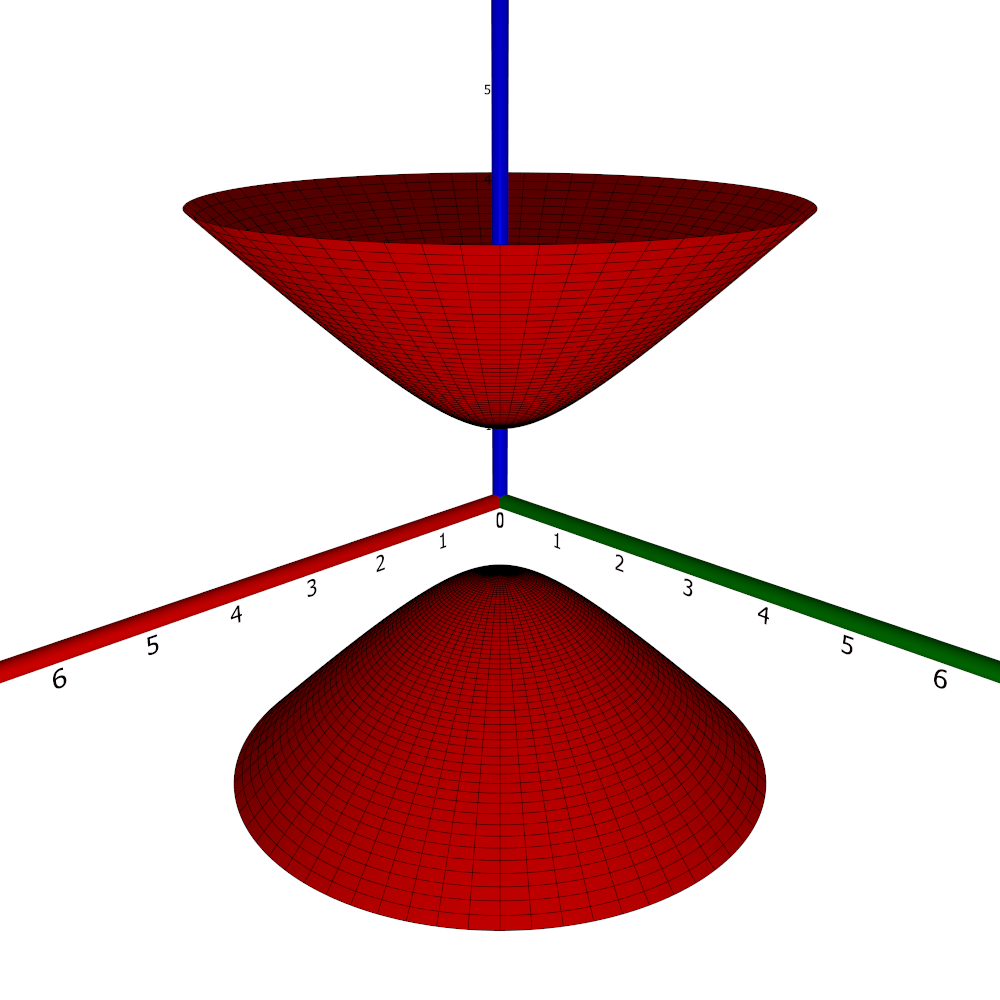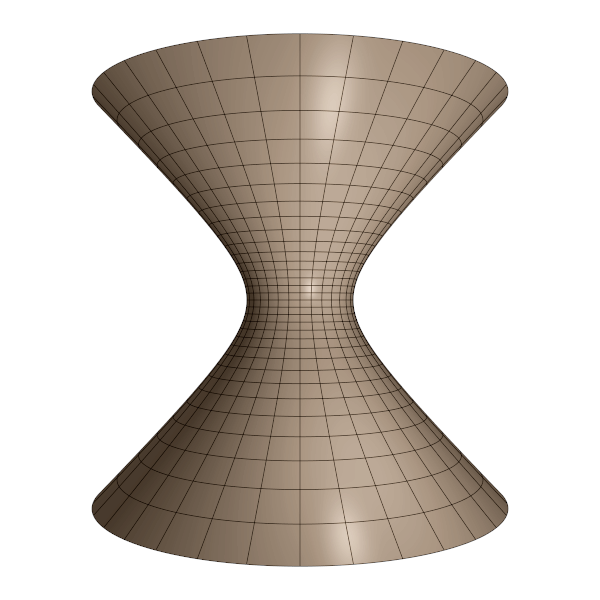Hyperboloid of two sheets
Object type: Surface
Definition
In $\mathbb{R}^3$, a hyperboloid of two sheets (or two-sheeted hyperboloid) is a set of points $(x,y,z)$ satisfying the equation $$\left(\frac{x}{a}\right)^2 + \left( \frac{y}{b}\right)^2 - \left(\frac{z}{c}\right)^2 = -1$$ for some constants $a, b, c > 0$.

Each intersection with a plane $z = c_0$, $|c_0| > c$, is an ellipse, and the intersections $x=0$ and $y=0$ yield hyperbolae. For this reason, the surface is also called an elliptic hyperboloid. If $a = b$, the intersections $z = c_0$ are circles, and the surface is called a circular hyperboloid, or a hyperboloid of revolution.
Parameterisation
Consider the circular hyperboloid of two sheets. This is a surface of revolution obtained as the hyperbola $$H := \left\{(x,y,z) \in \mathbb{R}^3: \left(\frac{x}{a}\right)^2 - \left(\frac{z}{c}\right)^2 = -1 \wedge x \ge 0 \wedge y = 0\right\}$$ is rotated about the $z$ axis. $H$ may be parameterised in several ways. Indeed, $$H = \mathbf{a}_+(\overline{\mathbb{R}^+}) \cup \mathbf{a}_-(\overline{\mathbb{R}^+}) = \mathbf{b}(\mathbb{R} \setminus \left]-1,1\right[)$$ where $$\mathbf{a}_\pm: t \mapsto (a\sinh t, 0, \pm c \cosh t)$$ and $$\mathbf{b}: t \mapsto (a\sqrt{t^2-1}, 0, ct).$$ Finally, the general elliptic hyperboloid is obtained from the circular hyperboloid by simple scaling along the axes. Thus, the hyperboloid of two sheets is the image $\mathbf{q}\left(\left(\mathbb{R}\setminus\left]-1,1\right[ \right)\times\left[0,2\pi\right[\right)$ where $$\mathbf{q}(u,v) = \underline{\mathbf{e}}\begin{pmatrix} a\sqrt{u^2-1}\cos v\\b\sqrt{u^2-1}\sin v\\cu\end{pmatrix}$$ and the component with $\text{sgn} z = \pm 1$ is also the image $\mathbf{r}_\pm(\overline{\mathbb{R}^+}\times\left[0,2\pi\right[)$ where $$\mathbf{r}_\pm(u,v) = \underline{\mathbf{e}}\begin{pmatrix}a\sinh u\cos v\\b\sinh u\sin v\\\pm c \cosh u\end{pmatrix}.$$ The image above shows the parameter curves of $\mathbf{r}_\pm$.
Properties (with respect to $\mathbf{r}_+$)
These properties are with respect to the parameterisation $\mathbf{r}_+$ given above, and hence concerns the upper component (with $z > 0$) of the hyperboloid. For brevity, we define $\mathbf{r} := \mathbf{r}_+$. (Needless to say, the lower component (with $z < 0$) behaves exactly the same.)
Parameter-curve tangent vectors
The parameter-curve tangent vectors are $$\mathbf{r}_u(u,v) = \underline{\mathbf{e}}\begin{pmatrix}a\cosh u \cos v\\b\cosh u\sin v\\c\sinh u\end{pmatrix}, \quad\quad \mathbf{r}_v(u,v) = \underline{\mathbf{e}}\begin {pmatrix}-a\sinh u\sin v\\b\sinh u\cos v\\0\end{pmatrix}.$$
Standard unit normal
The standard unit normal vector field is $$\mathbf{\hat{N}}(u,v) = \frac{1}{\sqrt{b^2 c^2 \sinh^4 u\cos^2 v + a^2 c^2 \sinh^4 u\sin^2 v + a^2 b^2 \sinh^2 u\cosh^2 u}} \underline{\mathbf{e}} \begin{pmatrix}-bc\sinh^2 u\cos v \\-ac\sinh^2 u\sin v\\ab\sinh u\cosh u\end{pmatrix}$$ which, in the case of a circular hyperboloid, reduces to $$\mathbf{\hat{N}}(u,v) = \frac{1}{\sqrt{a^2\cosh^2 u+c^2\sinh^2 u}}\underline{\mathbf{e}}\begin{pmatrix}-c\sinh u \cos v\\-c\sinh u\sin v\\a\cosh u\end{pmatrix}.$$
Area element
The area element is $$dA = \sqrt{b^2 c^2 \sinh^4 u\cos^2 v + a^2 c^2 \sinh^4 u\sin^2 v + a^2 b^2 \sinh^2 u\cosh^2 u}~dudv.$$ In the case of a circular hyperboloid, this reduces to $$dA = a\sinh u\sqrt{a^2\cosh^2 u+c^2\sinh^2 u}~ dudv.$$
First fundamental form
The first fundamental form is $$\mathcal{F}(u,v) = \begin{pmatrix}a^2\cosh^2 u\cos^2 v+b^2\cosh^2 u\sin^2 v+c^2\sinh^2 u&&(b^2-a^2)\sinh u\cosh u\sin v\cos v\\(b^2-a^2)\sinh u\cosh u\sin v\cos v&&a^2 \sinh^2 u\sin^2 v+b^2\sinh^2 u\cos^2 v \end{pmatrix}$$ which, in the case of a circular hyperboloid, reduces to $$\mathcal{F}(u,v) = \begin{pmatrix}a^2 \cosh^2 u +c^2 \sinh^2 u&&0\\0&&a^2 \sinh^2 u\end{pmatrix}.$$
Second fundamental form
The second fundamental form is $$\mathcal{M}(u,v) = \frac{abc\sinh u}{\sqrt{b^2 c^2 \sinh^4 u\cos^2 v + a^2 c^2 \sinh^4 u\sin^2 v + a^2 b^2 \sinh^2 u\cosh^2u}}\begin{pmatrix}1&&0\\0&&\sinh^2 u\end{pmatrix}$$ which, in the case of a circular hyperboloid, reduces to $$\mathcal{M}(u,v) = \frac{ac}{\sqrt{a^2\cosh^2 u+c^2\sinh^2 u}}\begin{pmatrix}1&&0\\0&&\sinh^2 u\end{pmatrix}.$$
Christoffel symbols
In the case of a circular hyperboloid ($a = b$), the Christoffel symbols are $$\Gamma^1_{\alpha\beta} = \frac{\tanh u} {a^2 + c^2 \tanh^2 u}\begin{pmatrix}a^2 +c^2&&0\\ 0&&-a^2\end{pmatrix}, \quad\quad \Gamma^2_{\alpha\beta} = \coth u \begin{pmatrix}0&&1\\1&&0\end{pmatrix}.$$
Curvatures
In the case of a circular hyperboloid ($a = b$), the principal curvatures are $$\kappa_1 = \frac{ac}{\left(a^2\cosh^2 u+ c^2\sinh^2 u\right)^{3/2}}, \quad\quad \kappa_2 = \frac{c}{a\sqrt{a^2\cosh^2 u+c^2\sinh^2 u}}$$ with corresponding principal directions $(1,0)$ and $(0,1)$, respectively. Thus, the Gaussian and mean curvatures are $$K = \frac{c^2} {\left(a^2\cosh^2 u+c^2\sinh^2 u\right)^2}, \quad\quad H = \frac{a^2 c+a^2 c\cosh^2 u+c^3 \sinh^2 u}{a\left(a^2\cosh^2 u +c^2\sinh^2 u\right)^{3/2}}.$$
Properties (with respect to $\mathbf{q}$)
These properties are with respect to the parameterisation $\mathbf{q}$ given above.
Parameter-curve tangent vectors
The parameter-curve tangent vectors are $$\mathbf{q}_u(u,v) = \underline{\mathbf{e}}\begin {pmatrix}au(u^2-1)^{-1/2}\cos v\\bu(u^2-1)^{-1/2}\sin v\\c\end{pmatrix}, \quad\quad \mathbf{q}_v(u,v) = \underline{\mathbf{e}}\begin{pmatrix}-a\sqrt{u^2-1}\sin v\\b\sqrt{u^2-1}\cos v\\0\end{pmatrix}.$$
Standard unit normal
The standard unit normal vector field is $$\mathbf{\hat{N}}(u,v) = \frac{1}{\sqrt{b^2 c^2 (u^2-1) \cos^2 v + a^2 c^2 (u^2 - 1) \sin^2 v + a^2 b^2 u^2}}\underline{\mathbf{e}}\begin{pmatrix}-bc\sqrt{u^2-1}\cos v\\ -ac\sqrt{u^2-1}\sin v\\abu\end{pmatrix}.$$ In the case of a circular hyperboloid, this reduces to $$\mathbf {\hat{N}}(u,v) = \frac{1}{\sqrt{(a^2+c^2)u^2-c^2}}\underline{\mathbf{e}}\begin{pmatrix}-c\sqrt{u^2-1}\cos v\\ -c\sqrt{u^2-1}\sin v\\au\end{pmatrix}.$$
Area element
The area element is $$dA = \sqrt{b^2 c^2 (u^2-1) \cos^2 v + a^2 c^2 (u^2 - 1) \sin^2 v + a^2 b^2 u^2}~ dudv.$$ In the case of a circular hyperboloid, this reduces to $$dA = a\sqrt{(a^2+c^2)u^2-c^2}~dudv.$$
First fundamental form
The first fundamental form of the hyperboloid of two sheets is $$\mathcal{F}(u,v) = \begin{pmatrix} a^2 u^2 (u^2-1)^{-1}\cos^2 v + b^2 u^2 (u^2 - 1)^{-1} \sin^2 v + c^2&&(b^2-a^2) u \sin v\cos v\\(b^2-a^2) u \sin v\cos v&&a^2 (u^2 - 1) \sin^2 v + b^2 (u^2 - 1) \cos^2 v\end{pmatrix},$$ which, in the case of a circular hyperboloid, reduces to $$\mathcal{F}(u,v) = \begin{pmatrix}a^2 u^2 (u^2 - 1)^{-1} + c^2&&0\\0&& a^2(u^2 - 1)\end{pmatrix}.$$
Second fundamental form
The second fundamental form is $$\mathcal{M} = \frac{abc}{\sqrt{b^2 c^2 (u^2-1) \cos^2 v + a^2 c^2 (u^2 - 1) \sin^2 v + a^2 b^2 u^2}} \begin{pmatrix}\frac{1}{u^2-1}&&0\\0&&u^2-1\end{pmatrix}$$ which, in the case of a circular hyperboloid, reduces to $$\mathcal{M} = \frac{ac}{\sqrt{(a^2+c^2)u^2-c^2}} \begin{pmatrix}\frac{1} {u^2-1}&&0\\0&&u^2-1\end{pmatrix}.$$
Christoffel symbols
In the case of a circular hyperboloid ($a=b$), the Christoffel symbols are $$\Gamma^1_{\alpha\beta} = \frac{-a^2 u}{(a^2+c^2)u^2-c^2} \begin{pmatrix}\frac{1}{u^2-1}&&0\\0&&u^2-1\end{pmatrix}, \quad\quad \Gamma^2_{\alpha\beta} = \frac{u}{u^2-1}\begin{pmatrix}0&&1\\1&&0\end{pmatrix}.$$
Curvatures
In the case of a circular hyperboloid ($a=b$), the principal curvatures are $$\kappa_1 = \frac{ac} {\left((a^2+c^2)u^2-c^2\right)^{3/2}}, \quad\quad \kappa_2 = \frac{c}{a\sqrt{(a^2+c^2)u^2-c^2}}$$ with corresponding principal directions $(1,0)$ and $(0,1)$. Hence, the Gaussian and mean curvatures are $$K = \frac{c^2}{\left((a^2+c^2)u^2-c^2\right)^2}, \quad\quad H = \frac{c\left(a^2+a^2 u^2+c^2 u^2−c^2\right)} {a\left((a^2+c^2)u^2-c^2\right)^{3/2}}.$$
